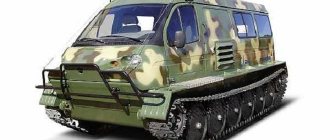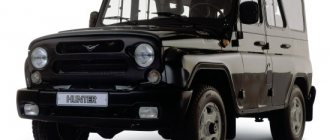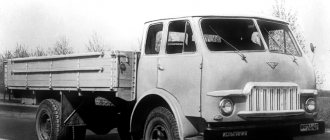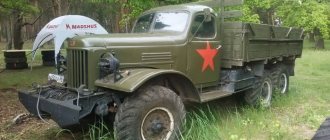The GAZ-71 tracked transporter is a truly unique and universal design. The vehicle can be used to transport cargo, personnel or tow trailers in off-road conditions. The sealed conveyor body allows you to cross water obstacles without any preparation of the machine.
The car was widely used in the northern regions, where it received a lot of nicknames - “Brute Dumb Force”, “Gasushka” or “Zhuzhik”. The GAZ-71 design had great potential for development and modernization. Currently, GAZ-3403 transporters are being produced, slightly different from their predecessor.
History of the creation of the all-terrain vehicle
The development of the GAZ-71 transporter began in the 60s. The vehicle was created on the basis of the GAZ-47 snow and swamp-going vehicle produced since 1955.
The characteristics of serial products began to lag behind the requirements of the main customer - the Soviet Army. It was planned to equip the new tracked all-terrain vehicle with a power unit and transmission unified with the components of the GAZ-66 wheeled army all-terrain vehicle.
The first prototype of the new tracked transporter was assembled in 1965.
A design feature of the experimental vehicles were plastic road wheels. However, the low strength of parts led to the abandonment of the use of plastic in serial products.
The new all-terrain vehicle used expanded caterpillar links, which, together with an increase in the length of the supporting surface, made it possible to reduce the pressure on the ground to 0.071 kgf/cm².
Serial production started in 1968 under the designation GT-SM. In the first years, the production of vehicles was carried out in Gorky, but due to the workload of the plant, production was moved to Zavolzhsk to a specialized plant for tracked tractors. The assembly of the conveyor in Zavolzhsk continued until 1985.
Links
- Types and diagrams of final drives of cars
- Types of single main gears
- Main gear with differential
- Main gear + fig. double final drive
| This is a preliminary article about technology. You can help the project by adding to it. This note should be replaced by a more precise one if possible. |
| This article or section contains a list of sources or external references, but the sources of individual statements remain unclear due to a lack of footnotes. Claims that are not supported by sources may be questioned and removed. You can improve the article by providing more accurate citations to your sources. |
Frame
At the heart of the GAZ-71 conveyor is a steel body welded from sheets of various thicknesses. The body is sealed, which allows the vehicle to overcome water obstacles without special training.
The body is divided into three sections:
- cabin;
- engine compartment;
- cargo platform.
The engine compartment is separated from the cabin and cargo part of the transporter by steel bulkheads. The bulkheads have removable hatches designed for servicing the power unit. A pump is installed in the engine compartment, designed to pump out liquid that enters when overcoming water barriers.
The GAZ-71 cabin is completely metal, equipped with two seats: for the driver and passenger.
Access to the cabin is through hinged side doors or through two hatches in the roof. The loading platform is made directly in the conveyor body. To facilitate unloading and loading, the upper part of the tailgate is hinged.
On the sides of the platform there are folding semi-soft seats. The platform is covered from above with a tarpaulin awning mounted on arches. To heat the internal volume of the cargo compartment, a separate liquid-type heater is used.
Engine
The GAZ-71 conveyor is equipped with a gasoline power unit with a carburetor fuel supply system. The engine has eight cylinders with a displacement of 4250 cm³ (4.25 l). Structurally, the engine is a modification of the power unit from GAZ-66 trucks. The engine develops a power of 115 hp.
Gasoline A-76 or AI-93 is used as fuel.
The plant allowed the engine to run on A-72 gasoline when installing an octane corrector for later ignition.
A special feature of the engine design is the installation of a standard P-16 heater running on gasoline. The heater warms up the coolant and oil in the crankcase for starting at low ambient temperatures.
Transmission gears and the coolness of the car, how are they related?
Knowing the concept of gear ratio, as well as its effect on speed, acceleration dynamics and fuel efficiency, allows you to choose the optimal driving mode. This parameter is of decisive importance for any car, regardless of its price and age. Few people know, but a competent analysis of the technical parameters before purchasing allows you to choose a car that ideally meets the owner’s needs. Let's consider the main aspects that need to be taken into account when choosing.
Transmission
The GAZ-71 conveyor is equipped with a mechanical four-speed gearbox and a dry clutch. The clutch design uses one disc with a diameter of 300 mm. The box is equipped with synchronizers in the two highest gears (fourth speed – direct). Switching the first two speeds is performed with throttle reversal. The operating range of the transmission is expanded by installing a transfer gearbox with overdrive and downshift gears.
The torque from the transfer gearbox is supplied to a single-stage main gear installed in an aluminum crankcase. A cardan shaft is used for transmission. Dry friction side clutches are installed at the output of the main pair.
Each clutch consists of 19 discs, which are controlled by a cam mechanism.
Clutches control single-stage final drives with spur gears. Axle shafts with gear couplings are used to connect clutches and gears.
Installing the final drive from GAZ 71 - logbook PTZavr amphibian 6x6 2012 on DRIVE2
]I decided to try installing the main gear with clutches from GAZ 71 on green. Since we received it in a sad state and did not spin at all, we are performing a complete disassembly to establish the condition and at the same time to familiarize ourselves with the design.
A fairly simple mechanism with a significant margin of safety for light machines. Especially for me, this is an obvious overkill, but there is nothing else in our industry.
And so let's get started.
General view with partial disassembly. The drums, cover and flange have been removed. I received a disassembled one and therefore the drums were separate.
Full size
The clutch packs can be removed quite simply, you just need to make a special key from a pipe for a nut with 4 grooves inside the packs. There are right and left threads and there is also a locking cup under the nuts, do not forget to bend the tongue.
The shank is pressed out quite tightly and removed together with the body. There are a lot of shims everywhere and not just one cardboard one.
Full size
Here are the packages and the tail assembled. All my disks are stuck together and I will have to disassemble and clean them.
Full size
Disassembled package. Everything is rusty.
Full size
The body is aluminum and quite lightweight.
Full size
Driven shaft. Main couple.
The shaft is quite simple and symmetrical. Its metal consumption is quite decent.
Full size
Tomorrow I'll weigh everything and measure something. If anyone has questions, ask until I have collected it.
In the future, I will install disc brakes and hydraulic control based on the VAZ clutch cylinders.
We reverse the rotation of the gearbox; to do this, we grind the housing by 5 mm.
Full size
Full size
Disc brakes.
Preparing the drums. The drum is cast iron, and in theory the disk should also be cast iron, but there is no such workpiece at hand. You can probably pick up a stove from the stove. For caliper 2108 you need a 370 mm disc with a 294 mm drum. I made it from steel and will screw it into the only possible place, but there is an option on the other side, but it is not yet clear how it was attached there and what the disk itself is made of.
Full size
Full size
Fitting.
Full size
www.drive2.ru
Control
To control the GAZ-71 conveyor, a system of levers and pedals is used. The pedal drive has a throttle valve and a clutch. Switching speeds in the gearbox and transfer gearbox is carried out by separate levers. The rotation is performed by disabling the side clutch clutches, the shutdown drive is carried out using levers.
To control various equipment, buttons and toggle switches located on the instrument panel are used.
Devices
An instrument panel is located on the central part of the dashboard of the GAZ-71 conveyor. On the sides of the shield there are deflectors for blowing hot air onto the windshield. The instrument panel consists of a free-standing speedometer and a rectangular console on which additional instruments, switches and indicator lamps are installed.
Closer to the speedometer there is an engine temperature indicator, behind which there is an oil thermometer, pressure gauge, ammeter and fuel level indicator in the tank. Since the GAZ-71 tracked all-terrain vehicle uses four fuel tanks, the dashboard has a level indicator switch between the tanks. To illuminate the devices, lamps installed above the devices are used.
Caterpillars
The GAZ-71 conveyor uses a steel small-link caterpillar, composed of 83 links each. The link has a width of 390 mm, the distance between the axes of the finger holes is 128 mm.
On the inner surface of the link there are two feathers that limit the treadmill and prevent the track from coming off the track rollers.
The links are connected to each other using steel fingers, secured against falling out with locking rings. To ensure the durability of the finger, the surface is saturated with boron, followed by hardening with high frequency currents. On the body between the first roller and the drive sprocket there is a removable plate that cleans the track from dirt and snow. The tracks are tensioned by turning the guide roller balancer crank.
Rollers
The GAZ-71 conveyor is equipped with six steel road wheels with a diameter of 700 mm with external rubber shock absorption. The rear rollers serve as idler wheels. The rollers are mounted on steel balancers.
The balancer suspension is torsion bar, supplemented with hydraulic shock absorbers. Telescopic shock absorber cartridges are installed on the balancers of the front rollers and idler wheels. The drive wheels are located at the front. The ring gear is equipped with 12 teeth, the unit is removable and interchangeable.
Where is?
We seem to have figured out the purpose of the car’s main gear; now it would be nice to find it. Doing this can be a difficult task, because the location of this unit can be different and depends on the type of machine drive and the imagination of the development engineers.
Fortunately, the flight of thoughts here is limited by the number of axes. So, for example, if we have front-wheel drive, then in this case the main gear of the car should be looked for in the gearbox along with the differential, in vehicles with rear drive wheels - directly in the rear axle. If all four are leading, then choose one of the above options.
Specifications
The main parameters of vehicles based on GAZ-71 are given below:
| Parameter | GAZ-71 | GAZ-34039 | GT-MU |
| Length, mm | 5390 | 5720 | 5146 |
| Width, mm | 2582 | 2550 | 2470 |
| Height, mm | 1740 | 2040 | 1700 |
| Load capacity, kg | 1000 | 1500 | — |
| Trailer weight, kg | 2000 | 200 | — |
| Curb weight, kg | 4950 | 4900 | 5800 |
| Capacity, persons | 10 | 12 | 8-10 |
The overall dimensions of the GAZ-71 allow the vehicles to be placed on a railway platform in pairs.
Application
Civilian transporters GAZ-71 are widely used in the Far North and Far East, where they make up a significant share of the fleet of all-terrain vehicles and tractors. The machine is used for delivery and supply of geological parties. Mobile drilling rigs were installed on the GAZ-71 base with equipment located on the front or rear of the hull.
An interesting modification of the machine is the installation for ice fishing (PT-ILT). In addition, on the basis of the GAZ-71, fire engines VPL-149A, short-circuit stations SKS-1A-02 and a number of other equipment were produced.
GAZ-71 all-terrain vehicles were used in the army to deliver personnel, small arms and mortars, and ammunition. The vehicle is designed to transport 10 people. The cargo compartment of the transporter can be used to transport the wounded on stretchers.
By order of the KGB border troops, border variants were produced under the designation GMP and GMP-1.
The equipment included night vision devices and various radio equipment. The roof of the driver's cabin was equipped with machine gun mounting points. A search and rescue version of the GT-PS was produced for the military space forces.
Based on the GAZ-71, the GT-MU airborne armored personnel carrier was developed. The upper part of the vehicle was protected by armor 4-6 mm thick; the bottom was made of ordinary steel sheet. The chassis has been shortened by one roller to reduce dimensions and reduce weight. The armored personnel carrier could be equipped with gasoline or diesel power units.
GAZ-3402D vehicles are equipped with a chassis identical to the GAZ-71. On the meringue GT-MU there were sanitary versions equipped with a cable winch for evacuating stretchers with the wounded. Combat vehicles could be used as artillery tractors or chemical reconnaissance vehicles.
Installing the final drive from GAZ 71 — logbook PTZavr amphibious 6×6 2012 on DRIVE2
]I decided to try installing the main gear with clutches from GAZ 71 on green. Since we received it in a sad state and did not spin at all, we are performing a complete disassembly to establish the condition and at the same time to familiarize ourselves with the design.
A fairly simple mechanism with a significant margin of safety for light machines. Especially for me, this is an obvious overkill, but there is nothing else in our industry.
And so let's get started.
General view with partial disassembly. The drums, cover and flange have been removed. I received a disassembled one and therefore the drums were separate.
Zoom
The clutch packs can be removed quite simply, you just need to make a special key from a pipe for a nut with 4 grooves inside the packs. There are right and left threads and there is also a locking cup under the nuts, do not forget to bend the tongue.
The shank is pressed out quite tightly and removed together with the body. There are a lot of shims everywhere and not just one cardboard one.
Zoom
Here are the packages and the tail assembled. All my disks are stuck together and I will have to disassemble and clean them.
Zoom
Disassembled package. Everything is rusty.
Zoom
The body is aluminum and quite lightweight.
Zoom
Driven shaft. Main couple.
The shaft is quite simple and symmetrical. Its metal consumption is quite decent.
Zoom
Tomorrow I'll weigh everything and measure something. If anyone has questions, ask until I have collected it.
In the future, I will install disc brakes and hydraulic control based on the VAZ clutch cylinders.
We reverse the rotation of the gearbox; to do this, we grind the housing by 5 mm.
Zoom
Zoom
Disc brakes.
Preparing the drums. The drum is cast iron, and in theory the disk should also be cast iron, but there is no such workpiece at hand. You can probably pick up a stove from the stove. For caliper 2108 you need a 370 mm disc with a 294 mm drum. I made it from steel and will screw it into the only possible place, but there is an option on the other side, but it is not yet clear how it was attached there and what the disk itself is made of.
Zoom
Zoom
Fitting.
Zoom
www.drive2.com
Modifications
The GAZ-71 transporter became the basis for the creation of several modifications:
- GAZ-3403, equipped with reinforced torsion bars, which made it possible to increase the load capacity to 1250 kg;
- GAZ-34033, intended for border troops, is equipped with a redundant electrical system;
- GT-MU, an armored transporter created on the basis of a symbiosis of GAZ-71 units and the GAZ-47 chassis.
Currently, the only version of the vehicle is produced under the designation GAZ-34039, on the basis of which drilling and fire-fighting rigs were created. Despite the age of the snow and swamp vehicle design, it is still actively used in the Far North.
Main steam gas 3110
The history of the Volga begins in 1956, when the first copy of the GAZ 21 passenger car rolled off the assembly line of the Gorky Automobile Plant. In 1970, the 21 was replaced by the new GAZ 24 model; in 1992-1996, the GAZ 31029 brand was produced. The GAZ 3110 model The basic version was produced from 1997 to 2004 - it became a modernized version of its predecessor.
Appearance of the classic Volga 3110 black











